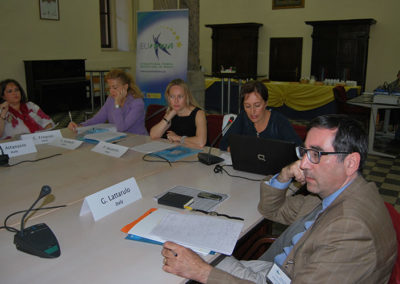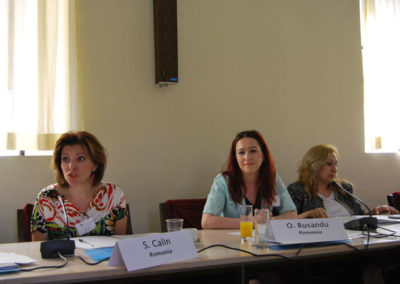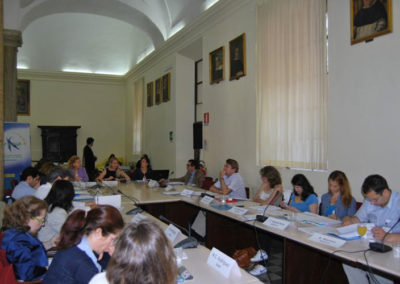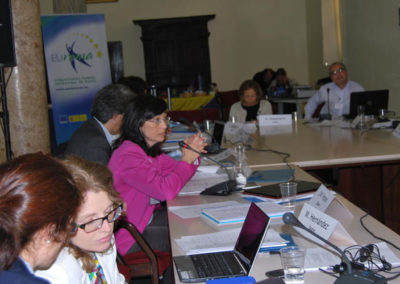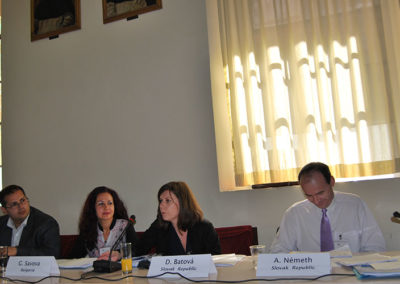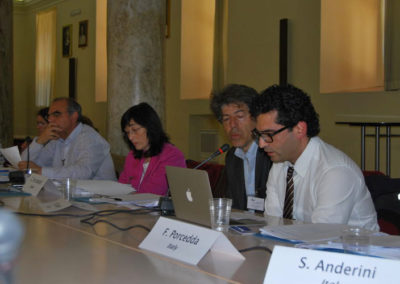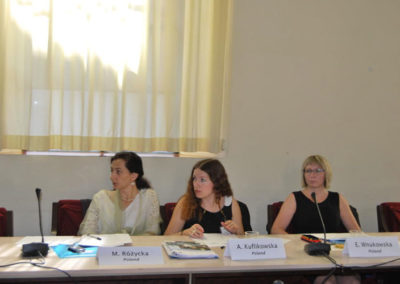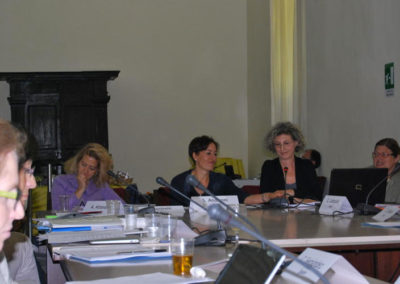The EURoma Network held its bi-annual meeting on 5th and 6th of June in Rome, hosted by the Italian partners of the Network. Recent developments in Partnership Agreements, new Operational Programmes and the future of Transnational Cooperation 2014-2020 were the core issues.
The gathering joint together around 50 representatives of EURoma partners involved in the Network (ESF and ERDF Managing Authorities and National Roma Contact Points), the European Commission (DG Employment, Social Affairs and Inclusion) and the Technical Secretariat, managed by the Fundación Secretariado Gitano, as well as Italian key stakeholders (Please see the participant’s list).
Welcoming words
Opening speeches were delivered by the Italian partners: Mrs. Antonella Attanasio, Head of Unit of Transnational Cooperation Unit at ISFOL, Mr. Marco de Giorgi, General Director, UNAR (National Office against Racial Discrimination – National Roma Contact Point) Department of Equal Opportunities – Presidency of the Council of Ministers and Mrs. Adriana Ciampa, Head of Unit, GD for Inclusion and Social Policies from the Ministry of Labour and Social Policy.
The Agenda
Setting the scene: European framework
The meeting started with an analysis of the recent developments as regards Roma Inclusion and Structural Funds at European level. Mr. Dominique Bé (Policy Officer, Unit D2, DG Employment, Social Affairs and Inclusion from the European Commission) highlighted the political milestones since the year 2004 and reminded that this European framework reached its momentum with the adoption of the European Framework for the National Roma Integration Strategies.
Mr. Bé stressed that eventhough there has been advancement within the legal and political framework, very low progress and tangible results have been reached. He took the opportunity to build on some key ideas to facilitate improvement in those areas: as for example support to national authorities to implement NRIS, higher efforts in fighting anti-gypsyism, closer support from the Commission to local authorities (as for example the ROMACT project), among other.
Mrs. Annette Björnsson (Policy Officer, Unit E1, DG Employment, Social Affairs and Inclusion from the European Commission) focused her intervention mainly on the current process of elaboration of Partnership Agreements. The European Commission has already received all Partnership Agreements, but for the moment only 4 have been adopted and 2 out of them mention the Roma minority in their documents.
The general approach of the Partnership Agreements already handed in is that Roma population is included as marginalized groups and that they should benefit from mainstreamed programmes (especially in those countries with large Roma populations) and that the strongest focus is set on the area of education. She recalled as well that Transnational Cooperation is currently compulsory and is still underused by Member States, eventhought this could be a relevant tool which opens up opportunities and cooperation on Roma relevant issues for Member States.
Roma Inclusion in Partnership Agreements and Operational Programmes
The next session was devoted to analyse how Roma needs are been taking into account in the elaboration of Partnership Agreements and Operational Programmes. To set the framework for debate, the “<https://www.euromanet.eu/upload/33/79/Report_EURoma_.pdf”>Main Findings and Conclusions of Structural Funds for Roma Inclusion” were presented based on the report carried out in 8 EU countries and elaborated in the context of the European Social Fund (ESF) Learning Network “Reinforcing policy learning for Roma inclusion” (the so-called EURoma+ Network). This document is one of the key tools of the Network to achieve its goal of transferring the knowledge gained on the use of Structural Funds for Roma inclusion in the programming period 2007-2013 to the period 2014-2020. Building upon the lessons learnt in the former programming period, the report elaborates policy messages and proposals for the upcoming one.
This presentation was followed by an open debate between Member States about key changes and progress foreseen in the new Partnership Agreements. Main issues stressed were that there’s a general feeling that in the next Programming Period Roma inclusion is more visible. In fact, many countries intend to address activities for Roma in more than one Operational Programme and with a diversity of models and approaches.
Members States pointed out that the local level will be more present in the next Operational Programmes and that funds will be directly allocated to local authorities, including resources to address the situation of settlements, were many Roma families still live. Another key issue highlighted and debated by Member States is how to reinforce capacity building of beneficiaries and intermediate bodies in order to improve the management and reporting of funds.
The debate focus as well on one of the main challenges for the next programming period which is that Roma could benefit from mainstreamed programmes and other general interventions. In that sense, Member States indicated that more efforts will be made on monitoring and follow-up of initiatives and that programmes and projects will be more result-oriented in order to ensure that the use of Structural Funds will benefit the Roma community and other vulnerable groups.
It was also emphasised that Member States are making progress in the combination of funds, mainly ESF and ERDF, within the next programming period. In that sense, structures and regulations are being shaped accordingly.
The Guide: “Making use of European Structural and Investment Funds for Roma Inclusion. A guide for Local Authorities”
A summarized presentation of the guide was delivered by the Technical Secretariat focused on the main messages, the potential impact and the role of Managing Authorities involving local authorities. Members of EURoma were invited to indicate how they foresee the use of this guide at national level and how to make an efficient dissemination to reach the adequate stakeholders. The edited version of the guide will be soon available at EURoma Website.
The Technical Secretariat emphasized that this guide could be a great tool to engage local authorities in the use of Structural and Investment Funds for Roma Inclusion in the future and in that sense, it was suggested that this publication should be translated into national languages so as to make it easy to read and use at local level.
Transnational cooperation in the 2014-2020 programming period: Assessment of EURoma Network work and discussion about the future cooperation among Member States.
The meeting provided the opportunity to review the work of the Network in the last 6 years and to assess the value of such initiative. Discussions were based on the outcomes of a questionnaire previously sent to the Members of the Network as well as other stakeholders. The survey analysed three main areas:
- The Network objectives, activities and results
- The Network composition and functioning
- The future of the Network and potential challenges
After the presentation of the main outcomes of the questionnaire, the participants had a lively debate on the results and future proposals. Furthermore, Members of the Network informed that there is political will at national level to support the continuity of the Network as well as their involvement in this initiative in the future. In that sense, in the coming months a proposal will be shaped including the suggestions made in the survey as of structure, the composition, main lines of action, etc.
Country Monograph
The second day of the meeting was mainly devoted to the country monograph with an in-depth presentation of the recent Italian developments on Roma inclusion and the use of Structural Funds. This part of the agenda was opened by Mrs. Paola Nicastro, General Director, Institute for Development of Vocational Training of Workers (ISFOL) who gave EURoma members a welcome speech and provided a general picture within the Italian context. This presentation was followed by Mr. Pietro Vulpiani, from the National Office Against Racism (UNAR), in charge of offering the milestones of the implementation of the Italian Strategy for Roma Inclusion.
Following the above mentioned presentations, Mrs. Silvia Sorbelli, from the Department for Development and Economic Cohesion (ERDF Managing Authority) highlighted key learnings from the former programming period and advanced on the role of the ERDF in the 2014-2020 programming period in support of the inclusion of the Roma people in Italy.
Mrs Cristina Freguja, Director, Socio-economic statistics Directorate, Italian National Institute of Statistics (ISTAT) presented an information system for monitoring social and economic integration of Roma, Sinti and Caminanti in Italy and provided relevant information of a pilot project for mapping data sources and settlements.
In order to contribute with the local viewpoint two presentations were delivered: Mrs Camilla Orlandi, Responsible for the Immigration Office, National Association of Italian Municipalities (ANCI) introduced the integrated governance system of social inclusion policies in favour of Roma and Sinti communities at local level in the framework of the National Strategy and highlighted the opportunities offered by European funds, and Mr. Giovanni Lattarulo, Head of Unit for Immigration Policies, Tuscany Region emphasised the implementation of the European and National Strategy for the Social Inclusion of Roma and Sinti in Tuscany Region.
Closing words
Final words were delivered by Mrs. Sabina Anderini, Transnational Cooperation Unit, ISFOL who thanked all participants for a productive meeting as well as the Technical Secretariat of the Network for mutual cooperation and gave all members of the Network a warm farewell.
RELATED DOCUMENTS
- Agenda
- Mr. Dominique Be’s Presentation
- Mrs. Anette Björnsson’s Presentation
- EURoma+ Report
- Guide “Making use of European Structural and Investment Funds for Roma Inclusion. A Guide for Local Authorities”
- Mr Vulpiani’s Presesntation
- Ms Silvia Sorbelli’s Presentation
- Ms. Freguja’s Presentation

